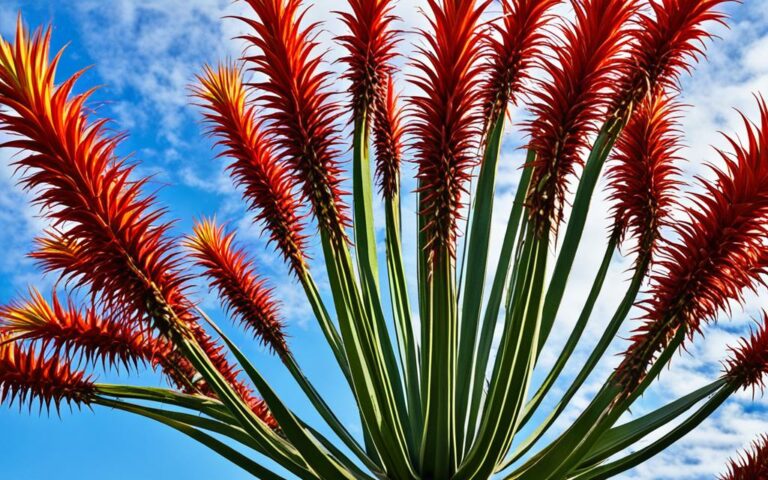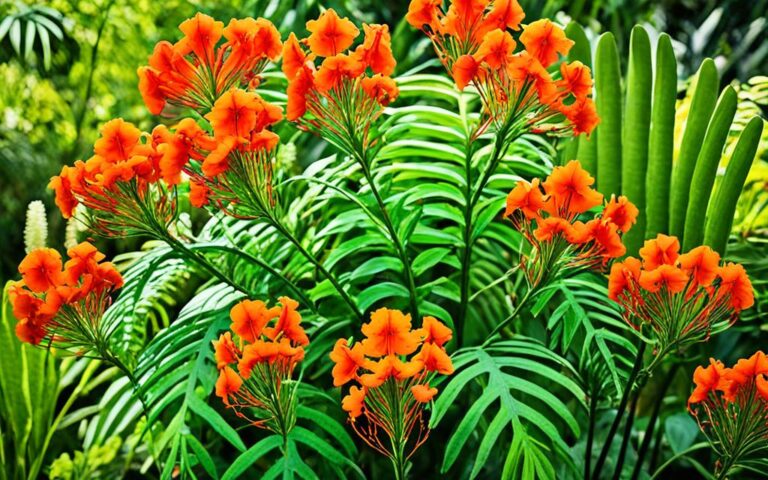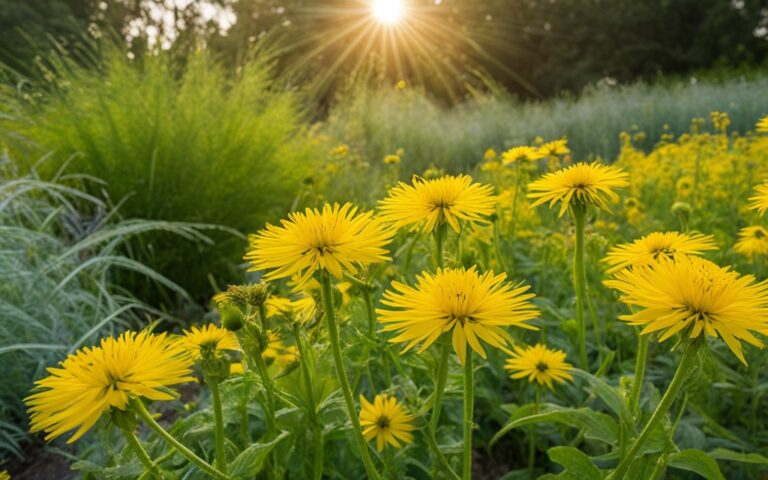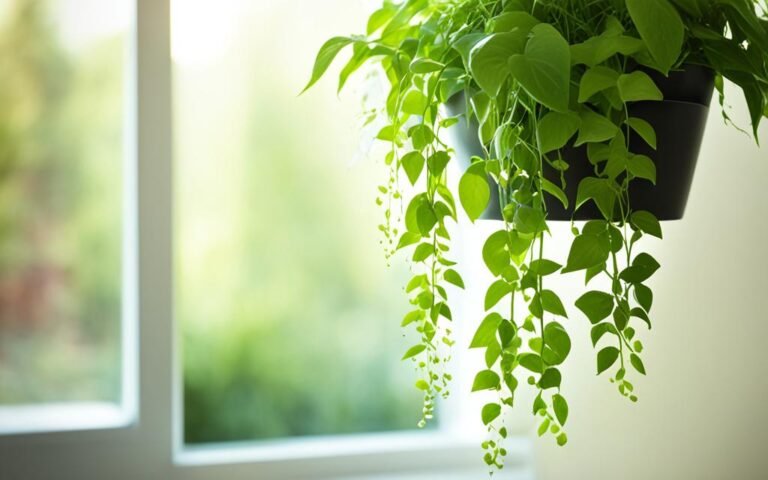Dragon’s Breath Plant: Vibrant Tropical Beauty
Did you know the dragon’s breath plant can grow up to 6 feet tall? It’s a real showstopper for any indoor or outdoor spot. Known as Alocasia ‘Dragon’s Breath’ or ‘Dragon Scale,’ it’s part of the Araceae family. Its leaves shine with a silvery-green color, catching everyone’s eye.
This plant is famous for its dramatic, arrow-shaped leaves. It thrives in many conditions, making it a favorite among plant lovers. Its popularity shows how it can make any space look better with its unique look.
Key Takeaways
- The dragon’s breath plant is a captivating tropical plant that can grow up to 6 feet tall.
- It is known for its striking, silvery-green foliage and arrow-shaped leaves.
- The plant has become increasingly popular among plant enthusiasts and collectors.
- Its versatility and eye-catching appearance make it a statement piece in any indoor or outdoor space.
- The dragon’s breath plant belongs to the Araceae family and is also known as the Alocasia ‘Dragon’s Breath’ or ‘Dragon Scale.’
Introduction to the Dragon’s Breath Plant
Botanical Classification and Origin
The dragon’s breath plant, known as Alocasia heterophylla ‘Dragon’s Breath,’ is a tropical perennial from Southeast Asia. It belongs to the Araceae family, which also includes popular houseplants like the monstera and philodendron. Its unique look and vibrant leaves have made it popular among plant lovers.
Rising Popularity and Appeal
In recent years, the dragons breath plant has become more popular. Its large, silvery-green leaves and potential height make it a favorite for indoor and outdoor spaces. The dragons breath plant’s unique look and striking foliage have boosted its appeal. It’s now a must-have for many plant collections.
| Key Facts | Details |
|---|---|
| Botanical Classification | Alocasia heterophylla ‘Dragon’s Breath’ |
| Plant Origin | Southeast Asia |
| Plant Family | Araceae |
| Popularity Trend | Surging in recent years |
| Plant Appeal | Striking appearance, large leaves, potential for impressive height |
“The dragon’s breath plant’s unique characteristics and eye-catching foliage have contributed to its growing appeal, making it a must-have addition to many plant collections.”
Captivating Foliage and Blooms
The dragon’s breath plant is famous for its dragons breath plant leaves and dragons breath plant foliage. These features are the main draw of this tropical gem. The leaves are large and shaped like arrows, with a unique silvery-green color and clear veins. They can grow up to 2 feet long, making a bold statement.
Not only does the dragon’s breath plant have striking dragons breath plant foliage, but it also boasts vibrant dragons breath plant flowers and dragons breath plant blooms. The flowers have a central spike, or spadix, surrounded by a spathe that looks like a leaf. The spathe can be green, red, or purple, adding to the plant’s beauty. Even though the flowers aren’t the main focus, they add to the plant’s dramatic look.
Distinctive Leaf Characteristics
- Large, arrow-shaped leaves up to 2 feet in length
- Distinctive silvery-green hue with prominent veining
- Unique leaf shape and coloration set the dragon’s breath plant apart
Vibrant Flower Structure and Colors
The dragon’s breath plant’s flowers have a central spike (spadix) surrounded by a spathe. This spathe can be green, red, or purple, making the plant stand out.
“The dragon’s breath plant is a true showstopper, with its captivating foliage and vibrant flowers that create a truly tropical and dramatic display.”
Dragons Breath Plant Varieties
The Alocasia ‘Dragon’s Breath’ is a popular choice, but there are many other types of dragon’s breath plants. Each one has its own look, with differences in leaf shape, size, and color. This lets gardeners pick the perfect plant for their space and style.
Common Species and Cultivars
Here are some top dragon’s breath plant species and cultivars:
- Alocasia ‘Dragon Scale’ – Its leaves look like dragon scales, with a unique texture.
- Alocasia ‘Regal Shields’ – This one has big, shiny leaves that look like royal shields.
- Alocasia ‘Polly’ – It’s smaller and has leaves shaped like arrows, in green and purple.
These dragon’s breath plants come in many styles, making it easy to add beauty to any spot. Whether you like the ‘Dragon Scale’ for its texture or the ‘Polly’ for its color, there’s a plant for you. They’re perfect for both indoor and outdoor spaces.
Understanding the Plant’s Anatomy
The dragon’s breath plant, known as Celosia, is a fascinating plant with an interesting anatomy. It has large, arrow-shaped dragon’s breath plant leaves on strong, upright dragon’s breath plant stems. These leaves have a silvery-green color and clear veins, making the plant stand out.
The dragon’s breath plant flowers are also unique. They have a central spadix surrounded by a leaf-like spathe. These flowers add beauty and interest to the plant’s look.
Special Features and Adaptations
The dragon’s breath plant has special features and adaptations for its tropical home. It can handle high humidity, making it good for both indoor and outdoor settings. The plant’s leaf shape and color also protect it from herbivores, helping it to thrive.
“The dragon’s breath plant is a true marvel of nature, with a captivating anatomy that has evolved to meet the challenges of its tropical environment.”
This plant is complex and interesting, with many features that help it grow and look its best. From its eye-catching leaves to its special adaptations, the dragon’s breath plant shows the beauty of nature.
Optimal Growing Conditions
Light and Temperature Requirements
The dragon’s breath plant needs bright, indirect light to do well. It should be near a sunny window but not in direct sunlight to prevent damage. It likes warm temperatures, between 59-80°F, and should stay away from cold spots or sudden changes.
Soil Preferences and Watering Needs
This plant prefers soil that drains well but holds moisture. A mix with peat moss or coco coir and perlite or vermiculite works great. It likes the soil to be moist but not soaked, so let the top inch or two dry out before watering again.
Here’s what the dragon’s breath plant needs to thrive:
- Bright, indirect light exposure
- Warm temperatures between 59-80°F
- Well-draining, nutrient-rich soil with good moisture retention
- Consistent moisture, but avoid waterlogging
“The dragon’s breath plant is known for its vibrant, almost neon-like foliage that thrives in the right growing conditions.”
Give the dragon’s breath plant the right light, temperature, soil, and water. This will help it grow well and show off its beautiful tropical look.
Propagating the Dragon’s Breath Plant
If you love the vibrant look of the dragon’s breath plant, you’ll find propagating it easy. It’s great for adding to your collection or sharing with friends. You can easily spread these tropical plants through division.
In the spring or early summer, when the plant is active, you can divide it. Cut the rhizome into sections, making sure each has roots and stems. Then, plant these in separate pots with good potting mix. This lets the new plants grow strong and healthy.
- Identify the plant’s active growth period, usually in spring or early summer.
- Carefully remove the dragon’s breath plant from its container or the ground.
- Use a sharp, sterilized knife or pruners to divide the rhizome into multiple sections, ensuring each section has roots and stems.
- Plant the divided sections in separate containers filled with well-draining potting mix.
- Water the newly planted divisions thoroughly and keep the soil consistently moist during the establishment phase.
- Provide the propagated plants with bright, indirect light and maintain optimal temperature and humidity levels.
- Monitor the divisions closely for any signs of pests or diseases, and address any issues promptly.
With proper care and the right conditions, your efforts in propagating dragon’s breath plants will pay off. You’ll have healthy, vibrant new plants to enjoy for many seasons.
“Propagating dragon’s breath plants is a rewarding way to expand your collection and share these stunning tropical beauties with others.”
Caring for Your Dragon’s Breath Plant
Keeping your dragon’s breath plant vibrant and healthy takes some care. We’ll cover key aspects like pruning, training, pest control, disease prevention, and fertilizing.
Pruning and Training Techniques
Pruning is key to keeping your dragon’s breath plant in shape and encouraging new growth. Use sharp pruners to cut off dead, damaged, or overgrown parts. This keeps the plant looking great and encourages new, healthy growth.
You can train the plant to grow in a certain way by guiding its stems and leaves. Use ties or stakes to help it grow in the shape you want. This keeps stems upright and leaves in place.
Pest and Disease Management
The dragon’s breath plant is tough but can get pests and diseases if not watched over. Watch your plant closely and deal with problems fast. Common pests like mealybugs, spider mites, and aphids can be fought off with insecticidal soaps or neem oil.
It can also get fungal diseases like root rot if the soil stays too wet. Make sure the soil drains well and don’t overwater to avoid this.
Fertilization for Optimal Growth
Regular fertilizing is key for your dragon’s breath plant’s vibrant leaves and size. Feed it a balanced, water-soluble fertilizer every month during spring and summer. Or, use organic compost or slow-release fertilizers for a steady release of nutrients.
With the right care, your dragon’s breath plant will be a stunning addition to your space. Learn about pruning, pest control, and fertilizing to keep it thriving and beautiful.
Benefits of Growing Dragon’s Breath Plants
Dragon’s breath plants are more than just pretty. They bring a tropical vibe to any space, making them a great choice for indoor or outdoor gardens. These plants are not just for looks; they have many benefits.
One big plus is how they clean the air. These plants absorb harmful toxins, making the air cleaner. This is great for homes and offices, helping everyone breathe easier.
They’re also easy to care for, perfect for all gardeners. Whether you’re new to plants or have years of experience, these plants are easy to keep happy. They add a unique touch to any garden.
Plus, their bright colors and unique leaves can spark creativity. Artists, designers, and writers find inspiration in these plants. They’re more than just plants; they have a deep cultural meaning.
In short, dragon’s breath plants have many benefits. They purify the air, are easy to care for, and inspire creativity. They’re a great choice for anyone looking to add something special to their space.
| Benefits of Growing Dragon’s Breath Plants |
|---|
| Vibrant, Tropical Focal Point |
| Air-Purifying Properties |
| Low-Maintenance and Adaptable |
| Inspiration for Creativity and Storytelling |
| Cultural Significance and Symbolic Meaning |
“The dragon’s breath plant is a true marvel of nature, offering a unique blend of visual splendor and practical benefits that make it a must-have for any gardener or plant enthusiast.”
Interesting Facts and Trivia
The dragon’s breath plant, known as Alocasia heterophylla, is a captivating tropical plant. It has many fascinating facts and trivia. From its unique name to its variable leaf shapes, it’s a true botanical wonder.
The name “dragon’s breath” comes from the plant’s vibrant foliage. It looks fiery, like the mythical dragon’s breath. This look has made the plant popular among plant lovers.
The scientific name, Alocasia heterophylla, means “variable leaf shapes.” The plant’s leaves can be arrow-shaped or rounded. This variety makes the dragon’s breath plant stand out from others.
| Dragon’s Breath Plant Trivia | Details |
|---|---|
| Botanical Name | Alocasia heterophylla |
| Common Names | Dragon’s Breath, Black Dragon |
| Leaf Characteristics | Variable, ranging from arrow-shaped to rounded |
| Origin | Tropical regions of Southeast Asia |
| Growth Habit | Upright and clumping |
| Preferred Conditions | Partial shade, consistent moisture, and well-draining soil |
These details make the dragon’s breath plant fascinating and unique. It’s a great addition to any plant collection or garden. Whether you’re new to plants or an expert, this beauty will surely captivate you.
Design Ideas and Display Tips
The dragon’s breath plant is big and eye-catching. It fits well in many indoor and outdoor settings. It can make a bold statement or bring a lush, tropical feel to any area.
At home, put the dragon’s breath plant where it can be seen, like near a window or by the door. Outside, it’s great in tropical gardens or pots. It also looks good in various containers, from simple planters to fancy ones.
Showcasing the Dragon’s Breath Plant Indoors
- Put the plant where it gets lots of light, like by a sunny window, to show off its colors.
- Use it as a centerpiece to catch the eye.
- Pair it with things like natural stone or rustic decor for a nice look.
Incorporating the Dragon’s Breath Plant in Outdoor Spaces
- Put it in tropical garden beds for a splash of color and texture.
- Use containers like big planters or hanging baskets for a lush look.
- Try different spots, like along paths or with other plants, to see what works best.
| Design Idea | Placement Tip | Benefit |
|---|---|---|
| Statement Piece | Near entryways or windows | Draws attention and creates visual impact |
| Tropical Garden Bed | Mixed with other lush, vibrant plants | Enhances the overall tropical ambiance |
| Container Display | In large planters or hanging baskets | Adds flexibility and versatility to the design |
With these ideas and tips, you can make the most of the dragon’s breath plant. It can turn any indoor or outdoor area into a beautiful and eye-catching place.
“The dragon’s breath plant is a true showstopper, with its vibrant foliage and striking presence. Incorporating this plant into your design scheme is a surefire way to add a touch of exotic flair and a wow factor to any space.”
Common Challenges and Solutions
The dragon’s breath plant is usually tough and stands strong. Yet, it can face some common issues. Discoloration or wilting of the leaves might happen due to wrong watering, not enough light, or lacking nutrients. By watching the plant closely and changing its care, growers can fix these problems fast. This keeps the dragon’s breath plant looking bright and healthy.
Also, the plant might get pests or diseases if not taken care of. Pests like mealybugs, spider mites, and aphids can be fought off with insecticidal soaps or neem oil. Fungal diseases, like root rot, can happen if the soil stays too wet. By being alert and fixing problems quickly, growers can keep their dragon’s breath plants healthy and full of life.
Troubleshooting Discoloration and Wilting
- Make sure the plant gets enough light and water. Change watering and lighting if needed to fix discoloration or wilting.
- Look for nutrient deficiencies and give the plant the right fertilizer to get better.
- Watch the plant’s environmental conditions, like temperature and humidity, and adjust them for the best growing spot.
Addressing Pests and Diseases
- Check the plant often for pests like aphids, spider mites, or mealybugs. Use insecticidal soaps or neem oil to treat them.
- Watch out for fungal diseases, such as root rot. Fix this by changing how you water and improving soil drainage.
- Keep the growing area clean and well-ventilated to stop pests and diseases from spreading.
| Common Pests | Identification | Treatment |
|---|---|---|
| Aphids | Found on new growth and flowers | Water pressure or oil treatments |
| Spider Mites | Tiny webbing on the plant | Neem oil and increased humidity |
| Mealybugs | White, fluffy clusters on the plant | Alcohol swabs and soapy sprays |
| Scale Insects | Bumps on stems and leaves | Cleaning with alcohol wipes and horticultural oil |
By quickly and effectively solving these common problems, dragon’s breath plant lovers can keep their tropical beauties looking vibrant and healthy.
Cultural Significance and Symbolism
The dragon’s breath plant, also known as the Celosia, is deeply important in many cultures. In Southeast Asia, it’s seen as a symbol of strength, power, and luck. Its bright leaf colors remind people of dragons, which are very important in Eastern traditions.
This plant can grow well even in tough places, showing it’s adaptable and can survive. The Dragonfire Kalanchoe is a popular type. It’s often given as a gift or used in festivals to wish for good luck because it’s easy to share and grow.
Kalanchoes, like the Dragonfire, have long meant wealth and growth. When its leaves turn from green to red, it shows change and starting fresh. This plant is also known for cleaning the air and helping with skin problems or burns, adding to its importance.
In Feng Shui, the dragon’s breath plant is linked to making money and being prosperous because of its red leaves. It’s seen as a symbol of personal strength, lasting through tough times, and making people feel better. It’s a key part of many cultural traditions and shared experiences.
“The dragon’s breath plant is a natural conversation starter, fostering communal care and a sense of unity in shared spaces like community gardens or classrooms.”
Worldwide, the dragon’s breath plant is valued for its beauty, toughness, and spiritual meaning. It stands for many things, like strength, courage, prosperity, and healing.
Conclusion
The dragon’s breath plant is a standout in any garden or plant collection. It has striking foliage, bright flowers, and a big size. This plant is popular and important in many cultures, making it a favorite among plant lovers.
By giving it the right care, gardeners can enjoy its dramatic look and bright colors for many years. It can be a main attraction or part of a lush, tropical garden.
This plant comes in four types, each with its own effects and uses. With proper care, it can be a centerpiece in any indoor or outdoor area.
In summary, the dragon’s breath plant is both beautiful and useful. By knowing what it needs, gardeners can grow a plant that will amaze and inspire for years.






